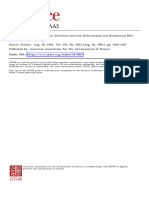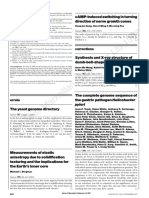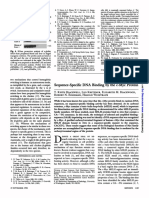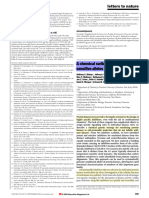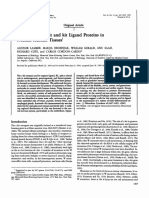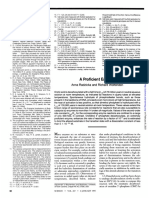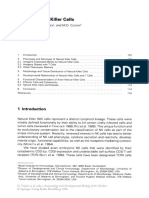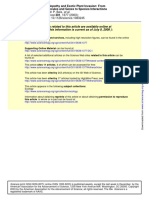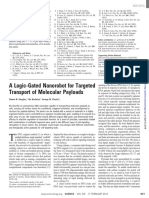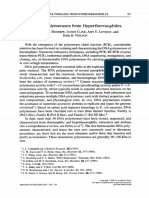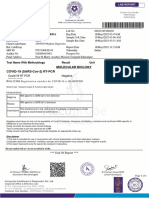American Association For The Advancement of Science
American Association For The Advancement of Science
Uploaded by
Vehpi YILDIRIMCopyright:
Available Formats
American Association For The Advancement of Science
American Association For The Advancement of Science
Uploaded by
Vehpi YILDIRIMOriginal Title
Copyright
Available Formats
Share this document
Did you find this document useful?
Is this content inappropriate?
Copyright:
Available Formats
American Association For The Advancement of Science
American Association For The Advancement of Science
Uploaded by
Vehpi YILDIRIMCopyright:
Available Formats
CREB: A Ca$^{2+}$-Regulated Transcription Factor Phosphorylated by Calmodulin-Dependent
Kinases
Author(s): Morgan Sheng, Margaret A. Thompson and Michael E. Greenberg
Source: Science, New Series, Vol. 252, No. 5011 (Jun. 7, 1991), pp. 1427-1430
Published by: American Association for the Advancement of Science
Stable URL: http://www.jstor.org/stable/2875923 .
Accessed: 24/10/2014 10:54
Your use of the JSTOR archive indicates your acceptance of the Terms & Conditions of Use, available at .
http://www.jstor.org/page/info/about/policies/terms.jsp
.
JSTOR is a not-for-profit service that helps scholars, researchers, and students discover, use, and build upon a wide range of
content in a trusted digital archive. We use information technology and tools to increase productivity and facilitate new forms
of scholarship. For more information about JSTOR, please contact support@jstor.org.
American Association for the Advancement of Science is collaborating with JSTOR to digitize, preserve and
extend access to Science.
http://www.jstor.org
This content downloaded from 146.201.200.226 on Fri, 24 Oct 2014 10:54:22 AM
All use subject to JSTOR Terms and Conditions
cell surface molecule that can recognize this 17. J. A. Bluestone, D. Pardoll, S. 0. Sharrow, B. J. demonstrating class II expression by mouse T cells
Fowlkes, Nature 326, 82 (1987). either taken from cultures or directlyfrom the animal
domain. 18. K. Haskins et al., J. Exp. Med. 160, 452 (1984). represent endogenous production or surface bound
The observation that only those CTLp's 19. H. M. Shapiro, PracticalFlow Cytometry(Liss, New molecules produced by other cells is controversial.
and Thp's that have been signaled through York, ed. 2, 1988), pp. 168-169. 27. F. Kiziroglu and R. G. Miller, J. Immunol. 146,
20. C. A. Smith, G. T. Williams, R. Kingston, E. J. 1104 (1991).
their antigen-specific surface receptors are Jenkinson, J. T. T. Owen, Nature 337, 181 (1989). 28. E. Azuma and J. Kaplan, ibid. 141,2601 (1988); D.
killed by exposure to an antibody recogniz- 21. The same may apply to B cells. In preliminary J. Cassell and J. Forman, ibid. 144, 4075 (1990).
ing all lymphocytes (anti-a3) may prove experiments, spleen cells exposed to the B cell mito- 29. S. Muraoka and R. G. Miller, J. Exp. Med. 152, 54
gen lipopolysaccharide (LPS) were induced to die (1980); H. Nakamura and R. E. Gress, Transplan-
useful for establishing tolerance in the adult when anti-a3 was also added. tation49, 931 (1990); T. Takahashi, K. Mafune, T.
animal to a particular antigen. 22. D. R. Kaplan, J. E. Hambor, M. L. Tycocinski, Proc. Maki, J. Exp. Med. 172, 901 (1990).
Natl. Acad. Sci. U.S.A. 86, 8512 (1989). 30. 0. Leo, M. Foo, D. H. Sachs, L. E. Samelson, J. A.
23. J. E. Hambor, D. R. Kaplan, M. L. Tycocinski, J. Bluestone, Proc. Natl. Acad. Sci. U.S.A. 84, 1374
REFERENCES AND NOTES Immunol. 145, 1646 (1990). (1987).
24. M. K. Newell, L. J. Haughn, C. R. Maroun, M. J. 31. M. J. Bevan and M. Cohn, J. Immunol. 114, 559
1. D. L. Mueller, M. K. Jenkins, R. H. Schwartz, Julius, Nature 347, 286 (1990). (1975).
Annu. Rev. Immunol.7, 445 (1989); K. J. Lafferty, 25. H. S. Ko, S. M. Fu, R. J. Winchester, D. T. Y. Yu, 32. R. G. Miller and M. Dunkley, Cell Immunol. 114,
S. K. Prowse, C. J. Simeonovic, H. S. Warren, ibid. H. G. Kunkel, J. Exp. Med. 150, 246 (1979); P. 284 (1974).
1, 119 (1983). Altevogt, J. Fohiman, J. T. Kurnick, P. Peterson, H. 33. J. Sambrook, E. F. Fritsch, T. Maniatis, Molecular
2. Lymphoid cells from one mouse strain (responder) Wigzell, Eur. J. Immunol. 10, 908 (1980); D. Cloning:A LaboratoryManual (Cold Spring Harbor
are cultured with inactivated (by irradiation) lym- Charron, E. G. Engleman, C. J. Benike, H. 0. Laboratory, Cold Spring Harbor, NY, ed. 2, 1989),
phoid cells from an MHC-different strain (stimula- McDevitt, J. Exp. Med. 152, 1275 (1980). pp. E3-4.
tor). Both CTL's (which kill) and T helpers (Th, 26. N. Koch, B. Arnold, G. J. Hammerling, J. Heuer, E. 34. __, ibid., p. B23.
which produce lymphokines such as IL-2) reactive Kolsch, Immunogen.17,497 (1983); J. Heuer and E. 35. We thank V. Wallace for providing the CD4 and
to MHC determinants of the stimulator are pro- Kolsch, J. Immunol.134, 4031 (1985); L. Graf, N. CD8 transfectants; F. Kiziroglu for discussion; and
duced. Class I MHC reactive cells carryCD8 and are Koch, V. Schirrmacher,Mol. Immunol. 22, 1371 B. H. Barber, E. A. McCulloch, and C. Paige for
predominately CTL's; class II reactive cells carry (1985); A. B. Reske-Kunz, K. Reske, E. Rude, J. critically reading the manuscript. Supported by
CD4 and are predominately Th's. The MHC is Immunol. 136, 2033 (1986). These investigators MRC of Canada (MT-3017) and by an MRC
called H-2 in the mouse. DBA/2 mice are H-2d and demonstratedproduction and expressionof low levels fellowship (S.S.).
carry class I MHC molecules Kd, Ld, and Dd. of classII MHC by particularmouse T cell lines in the
3. M. H. Claesson and R. G. Miller, J. Exp. Med. absenceof other cells. Whether resultsof other studies 11 December 1990; accepted 15 March 1991
160, 1702 (1984); P. J. Fink et al., J. Immunol.
133, 1769 (1984); P. J. Fink, H.-G. Rammensee,
M. J. Bevan, ibid., p. 1775.
4. R. G. Miller, in Strategiesof ImmuneRegulation,E. J.
Sercarz and A. J. Cunningham, Eds. (Academic
Press, New York, 1980), pp. 507-512; __ and
H. Derry, J. Immunol. 122, 1502 (1979); R. G.
Miller, Nature 287, 544 (1980); Immunol. Today 7,
112 (1986); P. J. Fink, R. P. Shimenkovitz, M. J. CREB: A Ca2+-Regulated Transcription Factor
Bevan, Annu. Rev. Immunol. 6, 115 (1988); H.-G.
Rammensee, Int. Rev. Immunol.4, 177 (1989).
Phosphorylated by Calmodulin-Dependent Kinases
5. R. D. Salter et al., Nature 345, 41 (1990); J. M.
Connolly, T. H. Hansen, A. L. Ingold, T. A. Potter, MORGAN SHENG,*t MARGARET A. THoMPSON,t
Proc. Natl. Acad. Sci. U.S.A. 87, 2137 (1990).
6. S. R. Sambhara, M. Skinner, P. Benveniste, R. G. MICHAEL E. GREENBERGt
Miller, in preparation.To generate the lines, MLR's
were set up, restimulated after 10 and 20 days, and
then sorted after 24 days into CD4- CD8+ and
The mechanism by which Ca2+ mediates gene induction in response to membrane
CD4- CD8- fractions, which were subcultured depolarization was investigated. The adenosine 3',5'-monophosphate (cAMP) re-
with fresh stimulator cells and a source of IL-2. sponse element-binding protein (CREB) was shown to function as a Ca2+-regulated
Subcultures with lytic activity were confirmed as
CD4- CD8- or CD4- CD8+ before further char- transcriptionfactor and as a substratefor depolarization-activatedCa2+-calmodulin-
acterization and use. dependentprotein kinases (CaMkinases)I and II. CREB residue Ser'33was the major
7. S. L. Swain,Immunol.Rev. 74, 129 (1983). site of phosphorylation by the CaM kinases in vitro and of phosphorylation after
8. 0. KanagawaandR. Maki,J. Exp. Med. 170, 901
(1989). membranedepolarizationin vivo. Mutation of Ser'33 impairedthe abilityof CREB to
9. V. A. Wallace, P. S. Ohashi, H. Hengartner, T. W. respond to Ca2+. These results suggest that CaM kinases may transduce electrical
Mak,Eur.J. Immunol.20, 2471 (1991).
10. When analyzed on a Becton-Dickenson FACScan
signals to the nucleus and that CREB fuinctionsto integrate Ca2' and cAMP signals.
after staining for CD4 and CD8, only the appropri-
ate transfectants differed significantly from control. D NA ELEMENTS THAT CONTAIN THE tein CREB on amino acid residue Ser'33
These were 15 times (CD4 transfectant) and 40
times (CD8 transfectant) brighter than control. consensus sequence TGACGTCA (4). Phosphorylation of Ser'33 stimulates
When stained for H-2k, the lines were 10 times were originally identified as cAMP the ability of CREB to activate gene tran-
(parental), 18 times (CD4+), and 16 times (CD8+) response elements (CREs) in neuropeptide scription (6), suggesting that CREB may
as bright as control. All distributions were log
normal with, for the broadest distribution, maxi- genes (1), but recent studies in neuronal cell mediate transcriptional induction by Ca2"
mum width at half height being defined by approx- lines have mapped inducibility by mem- as well as by cAMP. However, because
imately one-half and twice the peak intensity.
11. K. Ozato, N. M. Mayer, D. H. Sachs, Transplanta-
brane depolarization and increased intracel- multiple CRE-binding proteins exist (7, 8),
tion 34, 113 (1982). lular Ca2" concentrations to similar se- distinct members of this family may sepa-
12. G. A. Evans, D. H. Marqulies, B. Skykind, J. G. quences in the cfos (2-4) and proenkephalin rately confer Ca2" and cAMP inducibility
Seidman, K. Ozato, Nature 300, 755 (1982).
13. As a negative control, anti-a3 does not recognize genes (5). Depolarization of PC12 pheo- on the CRE (4). To determine whether
(11) and did not inhibit C3H (H-2k) responder cells chromocytoma cells is correlated with rapid CREB functions as a Ca2"-activated tran-
in an MLR. Nor did it inhibit anti-CD3-induced phosphorylation of the CRE-binding pro- scription factor and to test if phosphoryla-
activation of C3H spleen cells.
14. K. Ozato and D. H. Sachs, J. Immunol. 126, 317 tion-of Ser133 is important for this activa-
(1981). Department of Microbiology and Molecular Genetics, tion, we have targeted CREB to a different
15. H. Allen, D. Wraith, P. Pala, B. Askonas, R. A. Harvard Medical School, Boston, MA 02115.
Flavell, Nature 309, 279 (1984).
DNA regulatory sequence by fusing it to the
16. It is known (12) that 28-14-8S also binds to a3 of *Present address: Howard Hughes Medical Institute, DNA-binding and dimerization domain of
Ld. It inhibited H-2d responder cells, but only at University of California School of Medicine, San Fran- the yeast transcriptionalactivator GAL4 (9)
concentrations 2 3,g/ml. Ld expression is known to cisco, CA 94143s
be lower than that of Kd or Dd [W.-R. Lie et al., tThe first two authors contributed equally to this report.
(Fig. 1). The use of a reporter gene that
Nature 344, 439 (1990)]. tTo whom correspondence should be addessed. contains GAL4 binding sites allowed a spe-
7 JUNE 1991 REPORTS 1427
This content downloaded from 146.201.200.226 on Fri, 24 Oct 2014 10:54:22 AM
All use subject to JSTOR Terms and Conditions
cific functionalanalysisof CREB without main either by itself (10) or fused to an construct(Figs. 1B and 2); however, the
interferencefromendogenousCRE-binding acidic activatingregion (GAL4-B17) (11) magnitudesof Ca2+ and cAMP induction
proteins. was unableto conferCa2+ inducibility.As were reduced.Similarly,GAL4-CREBpro-
When cotransfectedinto rat PC12 cells expected,the GAL4-CREBfusionalsocon- teins with other point mutationsor small
with a humancfos reportergene that con- ferred cAMP-inducibleexpressionon the deletionswithin the CREB leucine zipper
tainedone GAL4 bindingsite (pAF42G1), GAL4 binding site (Fig. 1B) (12). The region that preventdimerization(14) also
the GAL4-CREB fusion construct con- levels of inducibilitywith Ca2+ and cAMP confer Ce2+ and cAMP inducibility, but with
ferredCa2+ inducibility(Fig. 1B). In the were similar,suggesting that CREB func- reducedefficincy (10). The leucine zipper
absenceof stimulation,no transcriptswere tions as a transcriptionalregulatorthat is may be importantfor folding the CREB
detected from transfectedor endogenous responsiveto both second messengers.In dimerinto an optimalconformationfor tran-
c{fos genes. When the intracellularCa"2 contrast, GAL4-CREB did not mediate scriptionalactivation.Ahermatively, a portion
concentrationwas increasedby K+ depolar- transcriptionalactivationby the proteinki- of the Ca2' and cAMPresponsesseen with
ization or by treatment with the Ca2+ nase C activator12-0-tetradecanoylphor- GAL4-CREBmay be due to dimerization
ionophoreA23187, the majorCa2"-induc- bol-13-acetate(TPA) (Fig. 1B). with endogenousCREBproteins.
ible transcriptcorrespondedto correctly BecauseGAIA-CREBcontains the leu- To determinewhetherphosphorylation of
initiatedhumanc-fos (cfosH) mRNA. The cine zipper dimerizationmotif (13, 14), CREBis functionallyimportantfor depolar-
GAL4-CREB fusion protein conferred a endogenousPC12 proteinsthatcontainleu- ization- and Ca2+-dependentactivationof
level of induction comparableto that ob- cine zippers might interact with GAL4- transciption,we mutatedthe majorsite of
served in depolarized PC12 cells trans- CREBandcausethe observedtranscription- CREBphosphorylation in depolarizedPC12
fected with a reportergene containing a al activation.To test this possibility,we cells(Ser133)to alanine.Thismutation(Ml)
CRE (Fig. 1B). constructeda GAL4-CREBmutantin which reduced by -80% the ability of GAL4-
The Ca2"-dependentinductionof cfosH the leucinezipperwas deletedbut the GALA CREBALZto mediatetranscriptional activa-
by GAL4-CREBrequiredthe GAL4 bind- DNA-bindingand dimerizationdomainsre- tion by either membranedepolarizationor
ing site and was dependenton the CREB mainedintact(GAL4-CREBALZ) (Fig. 1A). cAMP (Fig. 2). The Ml mutationdoes not
moiety of the GAL4-CREBfusion protein GALA-CREBALZ conferredboth Ca2+ and affectthe stabilityof CREB or its nudear
(Fig. 1B). The GAL4 DNA-binding do- cAMP inducibilityon the GAL4 reporter localization(6). These resultssuggest that
Ca2+-dependent phosphorylation of Serl33is
importantforCREBactivationby membrane
Fig. 1. Analysis of GAL4-CREB fiisions by A depolarization.However,mutationof Ser'33
cotransfection assay. (A) Structure of GAL4- GAL4-CREBt Ser13 312 341
CREB fusions and reporter genes (27). GAL4- 1GAL(1-147) CREB 12
did not completely abolish the ability of
B 17 contains an acidic activating region (11) GAIA-CREBALZ to confereitherCa2+or
fused to GAL4 (1 to 147), the DNA-binding GAL4-B17 cAMP inducibility.The basisof this residual
domain of GAL4 (9). GAL4-CREB contains the GAL4-1 7 activityis unclear(15).
complete CREB protein (341 amino acids) fused GAL4(1-147) B17 The transducingkinasethat couples the
to the COOH-terminus of GAL4 (1 to 147).
GAL4-CREBALZ lacks the COOH-terminal 29 TATA
depolarization-induced Ca2+ signal to the
Go -42
amino acids of GAL4-CREB, including the leu- phosphorylationand activationof CREB
cine repeat dimerization motif (LZ). GAL4- 1 x GAL4site may be a Ca2+-calmodulin-dependent pro-
CREBALZMI contains the Ser'33 to Ala muta- tein kinase(CaM kinase).CaM kinasesare
tion. The constructs pAF42G1 (GI) and G1 -42 TATA
activatedwhen the intracellularCa2+ con-
pAF42G9 (G9) contain, respectively, one and 9 x GAL4sites
nine GAL4 binding sites inserted at position -42 centrationis increasedaftermembranede-
in the core promoter construct pAF42 (GO), Gg -42 TATA polarization(16, 17), and inductionof cfos
which encodes the human c-fos gene (c-fos) (4). by depolarizationis specificallyinhibitedby
In pAF42CRE (CRE), the consensus CRE is 1 xCRE calmodulinantagonists(18). CaM kinasesI
inserted at position -42. (B) Ca2' and cAMP CRE 42 T
inducibility of reporter -42 and II havewide tissuedistributionsbut are
genes with GAL4-CREB especially abundantin neural tissues (17,
constructs. GAL4-CREB B U K+ F U K+ F A2 T U K+ F K+ A2 F U K+ F 19). CaM kinaseII has been implicatedin
fision constructs (5 jig) :: diverseregulatoryprocessesin the nervous
were transiently cotrans-
fected into PC12 cells
system, induding long-term potentiation
(3, 4) with reporter con- (LTP) (20). The CaM kinase I substrates
structs pAF42Go (GO) _. ... synapsinI and proteinIII areboth neuron-
or pAF42G, (GI) (20 ....... specificproteinsthat arephosphorylatedon
jig), as indicated. CRE ~~C-fos
g jP
z3SksN RB_0-!.... a singlecommonaminoacidresidueby both
(20 jig) was transfected
3
alone because the CRIE
cAMP-dependent proteinkinase(PKA)and
Caninteract with endog- CaM kinase I (17, 21). The fact that a
enous CREB. An commonresiduein CREB (Ser133) is phos-
h-globin expression plas- c-fosR4 4n i- cbi phorylatedin vivo in response to either
mid (pSVot-1; 3 jig) was
used as a control for
Ca2' or cAMP suggested the possibility
transfection efficiency. Reporter OREG GGo G thatCaMkinaseI maymediateCa2+-depen-
Cells were left unstimu- dent phosphorylationof CREB.
lated (U) or were stimu- Activator - GAL4-CREB GAL4-B17 GAL4-CREB GAL4-CREBALZ We tested whether purifiedCREB can
lated as indicated by 60 serveas a substratein vitrofor CaMkinaseI
mM K+ and 10 mM Ca2+ (KC), A23187 (10 jig/mI) (Al), or 10 jiM forskolin(F) for 60 mm~ or by TPA
(0.3 jig/mil) (T) for 30 min. Correctly in~itiatedtranscriptsfrom the transfected reporter gene (c?os),
or II. Two major GRE-bindingpolypep-
the endogenous rat gene (cf-osR),and the internal control gene (globin), were assayed by ribonuclease tides of 43 and 38 kD were purifiedby
(RNase) protection(3, 4) and areindicated.Bands abovecfosH representincorrectlyinitiatedtranscripts(28). DNA-affinitychromatography fromextracts
1428 SCIENCE, VOL. 252
This content downloaded from 146.201.200.226 on Fri, 24 Oct 2014 10:54:22 AM
All use subject to JSTOR Terms and Conditions
U K+ F U K+ F U K+ F Fig. 3. In vitro phos- A B C
phorylation of CREB Ca2+ + . + +
Jt
c-fos Hi3 ru:l and CREB B by purified CREB + + . . +
protein kinases. (A)
CaMkinaseII. (B) CaM
kinaseI. (C) PKA.Reac-
tions were performed -97
Globin- j ij with [32P]ATPat 300C
for5 min,andcontained
5 to 10 ng of affinity-
purified CREB (+
CREB)(29) or anequiv- CaMKUl
{ La -68
alent volume of buffer
c-fosH , _
(- CREB). CaMkinase a- *a CaMKi- " a * a -43
reactions (30) were per- a4 b S-* b b
Reporter
formed in the presence
G0 G9 G9 of Ca2 (+ Ca +) or in
GAL4-CREB ALZ ALZ ALZM1
the presence of excess
EGTA (- Ca24). La- -29
Fig. 2. Effectof the Ser'33to Ala mutationon beledproductsweresep-
GAL4-CREBALZ.Transienttransfectionassays aratedon SDS-polyacrylamide gels and visualizedby autoradiography.
The positionsof CREB and
were performed as in Fig. 1 with GAL4- CREBB aremarkedby "a"and"b",respectively.The autophosphorylated productsof CaMkinaseI
CREBALZor GAL4-CREBALZM1 andreport- (CaMKI) (37 to 42 kD) and CaMkinaseII (CaMKU) (51 to 53 kD and 60 kD) are indicated.A
er constructspAF42Goor pAF42G9as indicated. diffuseband of -80 kD in the PKA lane is not consistentlyseen between differentexperiments.
Bandsthatrepresentcorrectlyinitiatedtranscripts Positionsof molecularsize markersareindicatedin kilodaltons.
areindicatedas in Fig. 1.
co-workers (24). In addition, they have mumspecificitydeterminantfor CaMkinase
of mouse L cells. The 43-kD protein has the shown that phosphorylationof this site II (19), as well as to the PKA consensus
same molecular size as CREB purified from stimulatesthe abilityof CREB to activate recognition sequence (-Arg-Arg-X-Ser-)
brain or PC12 cells (22), comigrates with in an in vitroRNA polymerase
transcription (25). Overlapin the phosphorylationsitesof
CREB immunoprecipitated from PC12 II-dependent transcription system. The CaMkinaseII and PKA has been described
cells, and is quantitatively immunoprecipi- phosphorylationin vitro of a commonreg- for othersubstrates(26). Moreover,the Ser
tated by a CREB-specific antiserum (Fig. 3) ulatory site (Ser'33) by Ca2+- and cAMP- residuein synapsinI that is phosphorylated
(10). The 38-kD protein (termed CREB B) regulatedprotein kinases provides a bio- by both CaM kinaseI and PKA (21) lies
is likely to be a distinct CREB-related pro- chemical explanationfor how Ca2" and within a sequence (Arg-Arg-Arg-Leu-Ser-
tein (23). cAMP signalingpathwaysmight converge Asp) thatis similarto the CREBSer'33site.
Both CREB and CREB B are substrates to activateCREB in vivo. The finding that a regulatory site in
for CaM kinases I and II in vitro (Fig. 3). Analysis of the amino acids that flank CREBis phosphorylated by both Ca2"-and
After phosphorylation, both CREB and Ser'33in CREB (7) revealedthat this resi- cAMP-dependentprotein kinases in vitro
CREB B retain their ability to bind the due lies within a stretchof aminoacidsthe providesan explanationfor the observation
CRE, as determined by specific retention on sequenceof whichis consistentwith it being that CREB can mediate a transcriptional
a CRE-affinity column (10). We performed a recognitionsite for CaM kinasesI and II response to either Ca2+ or cAMP. Thus, the
two-dimensional tryptic phosphopeptide and PKA.The localpeptidesequence(-Ser- increasinglycomplex role of the CRE in
mapping to identify the sites of CREB phos- Arg-Arg-Pro-Ser'33-Tyr-Arg-) conformsto gene regulationmay be a reflectionof its
phorylation by CaM kinases I and II. The the motif -Arg-X-X-Ser(Thr)- (whereX rep- importanceas a target of multiple signal
major tryptic phosphopeptide (site 1) labeled resentsany aminoacid), which is the mini- transductionpathwaysin the cell.
in vitro by CaM kinases I and II comigrated
with the CREB tryptic fragment phosphoryl-
ated in vivo in response to increasedCa2+ (4) Fig. 4. Sites of CREB A B C
(Fig. 4). Tryptic peptide 1 contains Ser'33 as phosphorvlation bv
the only Ser or Thr residue (6, 7). We there- CaM kinase I, CaM ki-
nase II, and PKA. Two- 1 9 1
fore conclude that the major in vitro site of
dimensional tryptic
CREB phosphorylation by CaM kinases I phosphopeptide maps
and II is Ser'33. Whether CaM kinasesdirect- (4, 3 1) are shown.
ly phosphorylate CREB on Ser'33 in vivo CREB was phosphoryl-
remains to be determined. The two-dimen- atedinvitro by (A) CaM .
kinase I, (B) CaM kinase
sional tryptic maps revealed that in addition II, or (C) PKA, as indicated. (D) CREB B D E
to Ser133, CREB was consistently phospho- phosphorvlated by CaM kinase 11(32). (E) CREB
rylated by CaM kinases I and II at several immunoprecipitated from 32P-labeled PC12 cells
minor sites (Fig. 4), the significanceof which that had been subjected to K+-induced depolar- a.
is unknown. ization for 5 min (4). The major phosphopeptide
(marked "1") comigrates with the CREB trvptic 2
We found that CREB is a substrate for fragment phosphorylated in vivo in response to
PKA, as well as the CaM kinases, and that Ca2" in mixing experiments (10) and corresponds
the major site of phosphorylation by PKA is to phosphorylation of Ser'33 (4, 6). The track of
also Ser'33 (Fig. 4) (22). The ability of both faint spots trailing beneath phosphopeptide 1
varies in intensity between experiments and probably represents peptides phosphorvlated at the same
GaM kinase II and PKA to phosphorylate site that have not completely migrated to the major spot 1 position during chromatography. Origins are
GREB in vitro on the same site has been marked by a black dot. Electrophoresis at pH 1.9 was performed from left (+) to right (-), and
demonstrated independently by Dash and chromatography was performed in the ascending direction.
7 JUNE 1991 REPORTS 1429
This content downloaded from 146.201.200.226 on Fri, 24 Oct 2014 10:54:22 AM
All use subject to JSTOR Terms and Conditions
phy [J. T. Kadonaga and R. Tjian, Proc. Natt. Acad. and 1.5 mM CaCl2. In vitro phosphorylation by
REFERENCES AND NOTES Sci. U.S.A. 83, 5889 (1986)] on columns (40 ,ug PKA catalyticsubunit (20 to 40 ,ug/ml) (Sigma) was
1. R. H. Goodman, Annu. Rev. Neurosci. 13, 111 of DNA per milliliter) prepared from oligonucleo- performed in 10 mM Hepes (pH 7.2), 10 mM
(1990). tides of the following sequences: CRE column, MgCI2, 1 mM DIT, 10 ,uM ATP, and 1.5 ,uM
2. M. Sheng and M. E. Greenberg, Neuron 4, 477 5'-CCCGTGACGTCAACAC-3' and 5'-TGACG- [Y_32P]ATP.
(1990). TCACGGGGTGT-3'; AP-1 column, 5'-CCCGT- 31. K. Luo, T. R. Hurley, B. M. Sefton, Oncogene 5,
3. M. Sheng, S. T. Dougan, G. McFadden, M. E. GAGTCAACAC-3' and 5'-TGACTCACGGGG- 921 (1990).
Greenberg, Mol. Cell. Biol. 8, 2787 (1988). TGT-3' (consensus elements in italics). Nuclear 32. Two-dimensional tryptic analysis of CREB B phos-
4. M. Sheng, G. McFadden, M. E. Greenberg, Neuron extracts (200 mg of protein) were prepared from phorylation in vitro by CaM kinase I, CaM kinase II,
4, 571 (1990). 2 x 1011 mouse L cells by the chloroquine DNA and PKA reveals that the major phosphopeptide
5. T. V. Nguyen, L. Kobierski, M. Comb, S. E. intercalation method [H. Schroter, P. E. Shaw, A. labeled by these enzymes comigrates exactly with
Hyman, J. Neurosci. 10, 2825 (1990). Nordheim, Nucleic Acids Res. 15, 10145 (1987)]. phosphopeptide 1 labeled in CREB (Fig. 4) (10),
6. G. A. Gonzalez and M. R. Montminy, Cell 59, 675 We purified CREB by sequential passage through a suggesting that CREB and CREB B may possess a
(1989). serum response element column [R. Treisman, conserved phosphorylation site. Hai et al. (8) have
7. G. A. Gonzales et al., Nature 337, 749 (1989). EMBOJ. 6, 2711 (1987)], two CRE columns, one identified a protein, ATFI, that contains a sequence
8. T. Hai, F. Liu, W. J. Coukos, M. R. Green, Genes AP-1 column to rerove AP-1 proteins, and a final that is identical to the CREB peptide that contains
Dev. 3, 2083 (1989); J. P. Hoeffler, T. E. Meyer, Y. CRE column. CRE-binding activity was followed Ser'33. ATFI may therefore be identical to CREB
Yun, J. L. Jameson, J. F. Habener, Science 242, by gel shift assay (4). Purified CREB (-0.5 ,ug, as B.
1430 (1988); T. Maekawa et al., EMBOJ. 8, 2023 estimated by in vitro DNA-binding activity) was 33. We thank H. Schulman and N. Waxham for purified
(1989). concentrated in a Centricon ultrafiltration device CaM kinase II; A. Nairn for CaM kinase I; I.
9. I. Sadowski and M. Ptashne, NucleicAcids Res. 17, (Amicon, Danvers, MA) and dialyzed overnight Sadowski for pSG424; M. Carey for pG9E4T; and
7539 (1989). against 10 mM Hepes (pH 7.4) and 10% glycerol. M. Montminy for antiserum W39 to CREB and
10. M. A. Thompson, M. Sheng, M. E. Greenberg, 30. In vitro phosphorylation of CREB by purified rat RSV-CREBfM1. Supported by NIH grant RO1 CA
unpublished data. brain CaM kinase II (1 to 5 ,ug/ml) was performed 43855, grant ROI NS 28829 from the National
11. I. Sadowski, J. Ma, S. Triezenberg, M. Ptashne, in 50 mM Pipes (pH 7), 10 mM MgCG2, 1 mM Institute of Neurological Disorders and Stroke, an
Nature 335, 559 (1988). dithiothreitol (DIT), calmodulin (5 ,ug/ml), bovine American Cancer Society Faculty Research Award
12. L. A. Berkowitz and M. Z. Gilman, Proc.Natl. Acad. serum albumin (100 ,ug/ml), 10 ,uM adenosine (FRA-379) (M.E.G.), and a Scholar's Award from
Sci. U.S.A. 87, 5258 (1990). triphosphate (ATP), 1.5 ,uM [y-32P]ATP, and ei- the McKnight Endowment Fund for Neuroscience
13. W. H. Landschulz, P. F. Johnson, S. L. McKnight, ther 0.3 mM CaCl2 or 0.2 mM EGTA. In vitro (M.E.G.).
Science240, 1759 (1988). phosphorylation by CaM kinase I was performed as
14. V. J. Dwarki, M. Montminy, I. M. Verma, EMBO described (17) with 1 mM EGTA or 1 mM EGTA 20 December 1990; accepted 22 March 1991
J. 9, 225 (1990).
15. The slight residual activity of GAL-CREBALZMI
is in apparent disagreement with a previous report
(6) but may reflect the high sensitivity of the cfos
mRNA induction assay.
16. L. C. Griffithand H. Schulman, J. Biol. Chem. 263,
9542 (1988).
17. A. C. Nairn and P. Greengard, ibid. 262, 7273
Recognition of Self Antigens by Skin-Derived T Cells
(1987).
18. J. I. Morgan and T. Curran, Nature 322, 552 Sy Antigen Receptors
with Invariant
(1986).
19. R. J. Colbran et al., Biochem.J. 258, 313 (1989). WENDY L. HAvRAN, YUEH-HSIU CHIEN, JAMES P. ALLISON
20. M. B. Kennedy, Cell 59, 777 (1989).
21. A. J. Czernik, D. T. Pang, P. Greengard, Proc. Natl.
Acad. Sci. U.S.A. 84, 7518 (1987). Thy-l+ dendritic epidermal T cells (dECs) express invariant 'yi antigen receptors and
22. Z. Zhu, G. M. Andrisani, D. A. Pot, J. E. Dixon, J. are found in intimate contact with keratinocytes in murine epidermis-thus raising the
Biol. Chem. 264, 6550 (1989); M. R. Montminy
and L. M. Bilezikjian, Nature 328, 175 (1987); K. possibility that keratinocytes express a ligand for the antigen receptor of these T cells.
K. Yamamoto, G. A. Gonzalez, W. H. Biggs, M. R. Thy-I' dECs were stimulated to produce lymphokines by interaction with kerati-
Montminy, ibid. 334, 494 (1988). nocytes in vitro. This stimulation was mediated through the dEC antigen receptor and
23. Several observations suggest that CREB B is a
distinct CRE-binding protein rather than a degra- did not appear to be restricted by the major histocompatibility complex. Thus, dECs
dation product of CREB: it copurifies with CREB can recognize self antigens and may participate in immune surveillance for cellular
through multiple steps as a constant proportion of
the total protein; it is poorly immunoprecipitated by
damage rather than for foreign antigens.
an antiserum to CREB that is specific for an internal
CREB peptide (10); and its tryptic phosphopeptide
map is distinct from that of CREB (Fig. 4).
IN MICE, MOST T CELLS IN THE LYM- in the adult mouse (13). Similarly,the intra-
24. P. K. Dash, K. A. Karl, M. A. Colicos, R. Prywes, E. phoid tissues express diverse antigen epithelial T cells of the female reproductive
R. Kandel, Proc. Natl. Acad. Sci. U.S.A., in press. receptors that consist of acand i chains tract and the tongue express yb TCRs com-
25. B. E. Kemp, D. J. Graves, E. Benjamini, E. G. and recognize antigens bound to self major posed of an invariantV,4/J,,1-C,,l chain and
Krebs, J. Biol. Chem. 252, 4888 (1977).
26. T. R. Soderling, L. M. Schworer, M. R. El-Magh- histocompatibility complex (MHC) pro- an invariant8 chain identical to that found in
rabi, S. J. Pilkis, Biochem. Biophys. Res. Commun. teins. A minority of lymphoid T cells express the dECs (14). The absenceof clonal diversity
139, 1017 (1986); L. M. Schworer, M. R. El- clonally diverse y6 T cell receptors (TCRs) in the TCRs of these epithelium-associatedT
Maghrabi, S. J. Pilkis, T. R. Soderling, J. Biol.
Chem. 260, 13018 (1985); A. P. Doskeland et al., (1) and recognize a wide array of antigens, cells suggests that they might perform immu-
Eur.J. Biochem. 145, 31 (1984). including MHC class I, II, and lb gene nological fimctions that are distinct from
27. The complete coding region of the rat CREB cDNA
products, as well as bacterial heat shock those of T cells with clonally diverse antigen
(7) was amplified by the polymerase chain reaction
(PCR) and fused in frame to GAL4 (1 to 147) proteins (2-7). In contrast to the lymphoid receptors. These nondiverse T cells might
encoded in the plasmid pSG424 (9) to form GAL4- organs, severalepithelialtissues contain most- recognize damage-induced self antigens in a
CREB. The Ser'33 to Ala mutation (M1) was
subcloned (as an Aat II-Kpn I restriction fragment) ly y T cells. The epidermiscontains a unique mechanism of trauma signal surveillance(11,
into GAL4-CREB from the plasmid RSV- population of cells, the Thy- I' dECs (8-10), 15). Here, we provide evidence in support of
CREBfM1 (6) to generate GAL4-CREBM1. which express invariant y6 TCRs composed this concept by demonstrating that dECs can
GAL4-CREBALZ and GAL4-CREBALZM1 were
constructed by amplifying the corresponding re- of V,3/J,1-C,l and V,1/D,2/Jz2-C8 chains specifically recognize self antigens produced
gions from GAL4-CREB and GAL4-CREBM1 by (11, 12) and have not been found elsewhere by skin-derived keratinocytes.This informa-
PCR.
28. The two bands slightly above cfosH that are also
tion and the physical interactionsobserved in
detected in the ribonuclease (RNase) protection W. L. Havran and J. P. Allison, Department of Molec- situ lend support to a potential role of dECs
assay represent transcriptsinitiating from within the ular and Cell Biology, and Cancer Research Laboratory, in surveillanceof skin keratinocytesin vivo for
vector and from a cryptic mRNA start site in the University of California, Berkeley, CA 94720.
TATA region of the cfEos construct (4). Y.-H. Chien, Department of Microbiology and Immu-
damage induced by stress, infection, or other
29. CREB was purified by DNA-affinity chromatogra- nology, Stanford University, Stanford, CA 94305. means.
1430 SCIENCE, VOL. 252
This content downloaded from 146.201.200.226 on Fri, 24 Oct 2014 10:54:22 AM
All use subject to JSTOR Terms and Conditions
You might also like
- Hematology MCQsDocument84 pagesHematology MCQsHyder Ali84% (19)
- Cell Engineering 101Document20 pagesCell Engineering 101Vương HoàngNo ratings yet
- LeVay 1991 OriginalDocument5 pagesLeVay 1991 OriginalBAWA KONGNo ratings yet
- SimonDocument6 pagesSimonAlf GarisdedNo ratings yet
- Thompson1995 ScienceDocument8 pagesThompson1995 SciencePilar AufrastoNo ratings yet
- Multiple and Ancient Origins of Thedomestic DogDocument3 pagesMultiple and Ancient Origins of Thedomestic DogManuel D.PadillaNo ratings yet
- Saffran Et Al. 1996Document4 pagesSaffran Et Al. 1996aslansaim1911635No ratings yet
- Increased Insulin Senstivity ElcheblyDocument6 pagesIncreased Insulin Senstivity Elcheblyalejandra vazquez vazquezNo ratings yet
- Far-Red Radiation Adjacent An Early Signal of Competition in Plant CanopiesDocument4 pagesFar-Red Radiation Adjacent An Early Signal of Competition in Plant CanopiesrafiqcuNo ratings yet
- Paleogenomics of EchinodermsDocument6 pagesPaleogenomics of EchinodermsjesusNo ratings yet
- Typhimurium LT2Document5 pagesTyphimurium LT2api-27252976No ratings yet
- Kapitein 2005Document5 pagesKapitein 2005liliana-contrerasNo ratings yet
- DNArecDocument8 pagesDNArecmaricela cortes cobarrubiasNo ratings yet
- Letters To Nature: CorrectionsDocument15 pagesLetters To Nature: CorrectionsLisbeth Onsihuay CastroNo ratings yet
- Anderson 2005Document5 pagesAnderson 2005Joel JoseNo ratings yet
- SESIÃ"N 9 - Ciclo CelularDocument6 pagesSESIÃ"N 9 - Ciclo CelularIsaac LoyolaNo ratings yet
- 1990 - Sequence-Specific DNA Binding by The C-Myc ProteinDocument3 pages1990 - Sequence-Specific DNA Binding by The C-Myc ProteinRaymond LaBoyNo ratings yet
- Quality Control Mechanisms During TranslationDocument5 pagesQuality Control Mechanisms During TranslationpplowNo ratings yet
- Role of Genotype in The Cycle of Violence in Maltreated ChildrenDocument5 pagesRole of Genotype in The Cycle of Violence in Maltreated ChildrenMiquel AlaberniaNo ratings yet
- The Role of Locus Coeruleus in The Regulation of Cognitive Performance Marius Usher, Et Al. Science 283, 549 (1999)Document7 pagesThe Role of Locus Coeruleus in The Regulation of Cognitive Performance Marius Usher, Et Al. Science 283, 549 (1999)Ed Landau Add SolNo ratings yet
- Paper Target Validation Bump and HoleDocument7 pagesPaper Target Validation Bump and HolemarylenedemanNo ratings yet
- Hariri Et AlDocument4 pagesHariri Et AlJenniffer RiveraNo ratings yet
- Continuous Particle SeparationDocument5 pagesContinuous Particle SeparationAsmaaKhaterNo ratings yet
- Genetic Structure of Human Populations: EportsDocument5 pagesGenetic Structure of Human Populations: EportsMarziapieNo ratings yet
- Meyer 2005Document4 pagesMeyer 2005Dhruv.S.Chabria TIPSNo ratings yet
- Coster Ton 1999Document6 pagesCoster Ton 1999Iandra de Assis SilvaNo ratings yet
- Clark 1974Document3 pagesClark 1974Igor KatoNo ratings yet
- Bio Selective Membrane ElectrodeDocument6 pagesBio Selective Membrane Electrodeahmadalijee70No ratings yet
- Lammie Et Al 1994 Expression of C Kit and Kit Ligand Proteins in Normal Human TissuesDocument9 pagesLammie Et Al 1994 Expression of C Kit and Kit Ligand Proteins in Normal Human Tissuesvcox4460No ratings yet
- White 1999Document9 pagesWhite 1999antonio damataNo ratings yet
- Bakalyar and Reed 1990Document5 pagesBakalyar and Reed 1990harisankarhsNo ratings yet
- Rao BIO2000 2004-1Document100 pagesRao BIO2000 2004-1api-3700537No ratings yet
- Isolation of A CDNA Clone Derived From A Blood-Borne Non-A, Non-B Viral Hepatitis GenomeDocument4 pagesIsolation of A CDNA Clone Derived From A Blood-Borne Non-A, Non-B Viral Hepatitis GenomePatrícia KellenNo ratings yet
- Us 5434131Document32 pagesUs 5434131KRUBAKARAN MUTHUSAMYNo ratings yet
- Hiv Q1Document3 pagesHiv Q1Widi DwiNo ratings yet
- Science 1116598Document9 pagesScience 1116598Pinjala AnoopNo ratings yet
- Table of ContentsDocument65 pagesTable of ContentsМатиас Себальос ГусманNo ratings yet
- Inhibition of Viral Replication by IFNg Induced Nitric Oxide SynthaseDocument4 pagesInhibition of Viral Replication by IFNg Induced Nitric Oxide SynthaseSalazar Robles GabrielNo ratings yet
- ReferencesDocument4 pagesReferencesmakerk82No ratings yet
- A Proficient Enzyme: Anna Radzicka and Richard WolfendenDocument5 pagesA Proficient Enzyme: Anna Radzicka and Richard WolfendenNéstor Eduardo Gutiérrez SánchezNo ratings yet
- Enfermedades AviaresDocument11 pagesEnfermedades AviarestohorNo ratings yet
- Wolbachia Invades Anopheles StephensiDocument5 pagesWolbachia Invades Anopheles StephensiGina M LópezNo ratings yet
- Self-Assembly and Mineralization of Peptide-Amphiphile NanofibersDocument5 pagesSelf-Assembly and Mineralization of Peptide-Amphiphile NanofibersJosé Rodrigo Alejandro Martínez DíazNo ratings yet
- A Physical Map of 30,000 Human Genes: J. Am. Chem. Soc. 117, 4193 (1995) ), As DemonstratDocument3 pagesA Physical Map of 30,000 Human Genes: J. Am. Chem. Soc. 117, 4193 (1995) ), As DemonstratRahmat Eko SanjayaNo ratings yet
- Calcium Oscillations Increase The Efficiency and Specificity of Gene ExpressionDocument4 pagesCalcium Oscillations Increase The Efficiency and Specificity of Gene ExpressionVehpi YILDIRIMNo ratings yet
- The Following Resources Related To This Article Are Available Online atDocument5 pagesThe Following Resources Related To This Article Are Available Online atihzaoloanNo ratings yet
- MB502-T - Molecular Biology Handouts 1Document152 pagesMB502-T - Molecular Biology Handouts 1fahad shoukatNo ratings yet
- Vertebrae Retina ModelingDocument3 pagesVertebrae Retina ModelingNada Fitrieyatul HikmahNo ratings yet
- Caspases: Enemies WithinDocument6 pagesCaspases: Enemies WithinJuan manuel jiménez estradaNo ratings yet
- Paper1 FuDocument7 pagesPaper1 Fuapi-3700537No ratings yet
- A Logic-Gated Nanorobot For Targeted Transport of Molecular PayloadsDocument5 pagesA Logic-Gated Nanorobot For Targeted Transport of Molecular PayloadsJohnathonNo ratings yet
- Clark Et Al 2018 Extended Stability of Restriction Enzymes at Ambient TemperaturesDocument4 pagesClark Et Al 2018 Extended Stability of Restriction Enzymes at Ambient TemperaturesNaadiah MazlaniNo ratings yet
- (A. J. Jeffreys, S. D. J. Pena (Auth.), Prof. Dr.Document453 pages(A. J. Jeffreys, S. D. J. Pena (Auth.), Prof. Dr.aungNo ratings yet
- Control of Octopus Arm Extension by A Peripheral Motor ProgramDocument5 pagesControl of Octopus Arm Extension by A Peripheral Motor ProgramiwzvolxjNo ratings yet
- The Nature of Endothelium-Derived Vascular Relaxant Factor: - M May Replace The Murine f3rmDocument3 pagesThe Nature of Endothelium-Derived Vascular Relaxant Factor: - M May Replace The Murine f3rmJúlia Martins F. de SouzaNo ratings yet
- Hogrefe2001 Ensayo de Actividad EnzimáticaDocument26 pagesHogrefe2001 Ensayo de Actividad Enzimáticacristian037No ratings yet
- BIO302 PPT SlidesDocument287 pagesBIO302 PPT SlidesTayyaba ArbabNo ratings yet
- 1986 ODONOGHUE - THICK Morphological and Biochemical Correlates Compara Los 2 Mascorcopicos de Sheep y Habla Bastante de GiganteaDocument8 pages1986 ODONOGHUE - THICK Morphological and Biochemical Correlates Compara Los 2 Mascorcopicos de Sheep y Habla Bastante de GiganteaIgnacio GualNo ratings yet
- Sources of Mathematical Thinking: Behavioral and Brain-Imaging EvidenceDocument5 pagesSources of Mathematical Thinking: Behavioral and Brain-Imaging EvidenceFlorencia Carla CossiniNo ratings yet
- 8 Science 1999 Lahn 964 7Document5 pages8 Science 1999 Lahn 964 7Biologia UFRRJNo ratings yet
- Translating The Histone Code PDFDocument8 pagesTranslating The Histone Code PDFLorena RamosNo ratings yet
- Foundations of Ecology II: Classic Papers with CommentariesFrom EverandFoundations of Ecology II: Classic Papers with CommentariesNo ratings yet
- NRM 1155Document13 pagesNRM 1155Vehpi YILDIRIMNo ratings yet
- Ni Hms 104259Document20 pagesNi Hms 104259Vehpi YILDIRIMNo ratings yet
- Ni Hms 127412Document28 pagesNi Hms 127412Vehpi YILDIRIMNo ratings yet
- PNAS 2001 West 11024 31Document8 pagesPNAS 2001 West 11024 31Vehpi YILDIRIMNo ratings yet
- 883 FullDocument61 pages883 FullVehpi YILDIRIMNo ratings yet
- Regulation of Cell CycleDocument5 pagesRegulation of Cell CyclemohsinNo ratings yet
- Ba BSC Pii A2023Document138 pagesBa BSC Pii A2023ak9405264No ratings yet
- Protein Structure Determination and Prediction A Review of TechniquesDocument14 pagesProtein Structure Determination and Prediction A Review of TechniquesIJRRRNo ratings yet
- Polymerase Chain Reaction Detection and Phylogenetic Characterization of An Agent Associated With Yellow Vine Disease of CucurbitsDocument9 pagesPolymerase Chain Reaction Detection and Phylogenetic Characterization of An Agent Associated With Yellow Vine Disease of CucurbitsdvNo ratings yet
- Cell StructureDocument6 pagesCell StructureL.y. Chong100% (1)
- Cells and Organelles Notes and Color SheetDocument7 pagesCells and Organelles Notes and Color Sheetapi-236331206No ratings yet
- NBT 2623Document6 pagesNBT 2623ירדן לויןNo ratings yet
- Molecular Pathology - Cesium Chloride (CSCL) Density Gradient CentrifugationDocument2 pagesMolecular Pathology - Cesium Chloride (CSCL) Density Gradient CentrifugationShailendra YadavNo ratings yet
- DNeasy Blood Tissue ProtocolDocument2 pagesDNeasy Blood Tissue ProtocolSergio Joel Medina100% (1)
- Kuliah Umum TransfusiDocument54 pagesKuliah Umum TransfusiAnton TriyadiNo ratings yet
- Lab Report BIO301 1 & 2Document31 pagesLab Report BIO301 1 & 2Fahmy AmyNo ratings yet
- General Biology 1 First QuarterDocument10 pagesGeneral Biology 1 First QuarterAnjhiene CambaNo ratings yet
- Preclass Quiz 7 - Fa19 - MOLECULAR BIOLOGY (47940) PDFDocument3 pagesPreclass Quiz 7 - Fa19 - MOLECULAR BIOLOGY (47940) PDFElizabeth DouglasNo ratings yet
- Dissertation Methoden Western BlotDocument8 pagesDissertation Methoden Western BlotPaperHelpCanada100% (1)
- Protein Quality Comparison Chart: SourceDocument1 pageProtein Quality Comparison Chart: SourceCésar Vizcarra Del RíoNo ratings yet
- 5 HemostasisDocument35 pages5 Hemostasissamar yousif mohamedNo ratings yet
- Mitochondria: Structure and FunctionDocument6 pagesMitochondria: Structure and FunctionHariniNo ratings yet
- IBO Sample Questions TheoryDocument61 pagesIBO Sample Questions TheoryTania RomanNo ratings yet
- Molecular Biology COVID-19 (SARS-Cov-2) RT-PCR: 80994699 Mr.I C SharmaDocument1 pageMolecular Biology COVID-19 (SARS-Cov-2) RT-PCR: 80994699 Mr.I C SharmaMohd YasarNo ratings yet
- Endothelial Activation and Dysfunction in COVID-19: From Basic Mechanisms To Potential Therapeutic ApproachesDocument13 pagesEndothelial Activation and Dysfunction in COVID-19: From Basic Mechanisms To Potential Therapeutic ApproachesFarmasi Pelita IbuNo ratings yet
- Tea As A Natural Gift For Discovering Antiviral CandidatesDocument10 pagesTea As A Natural Gift For Discovering Antiviral CandidatesChristian ObandoNo ratings yet
- Rubrics 3D Dna ModellingDocument2 pagesRubrics 3D Dna ModellingRon D. ArtNo ratings yet
- Molecular Biology Workflow Solutions 11 16Document40 pagesMolecular Biology Workflow Solutions 11 16Isaac Nicholas NotorioNo ratings yet
- Description of Prototype Modes-of-Action Related To Repeated Dose ToxicityDocument49 pagesDescription of Prototype Modes-of-Action Related To Repeated Dose ToxicityRoy MarechaNo ratings yet
- Gene CloningDocument2 pagesGene CloningEagle SubbirNo ratings yet
- Cell Organelles WorksheetDocument8 pagesCell Organelles WorksheetErika Mae LibangNo ratings yet
- Exercise 2Document5 pagesExercise 2jamjamaeNo ratings yet
- Osteoarthritis: Pathophysiology: OA Is Primarily A Disease of CartilageDocument5 pagesOsteoarthritis: Pathophysiology: OA Is Primarily A Disease of CartilageLinda SugiartoNo ratings yet


